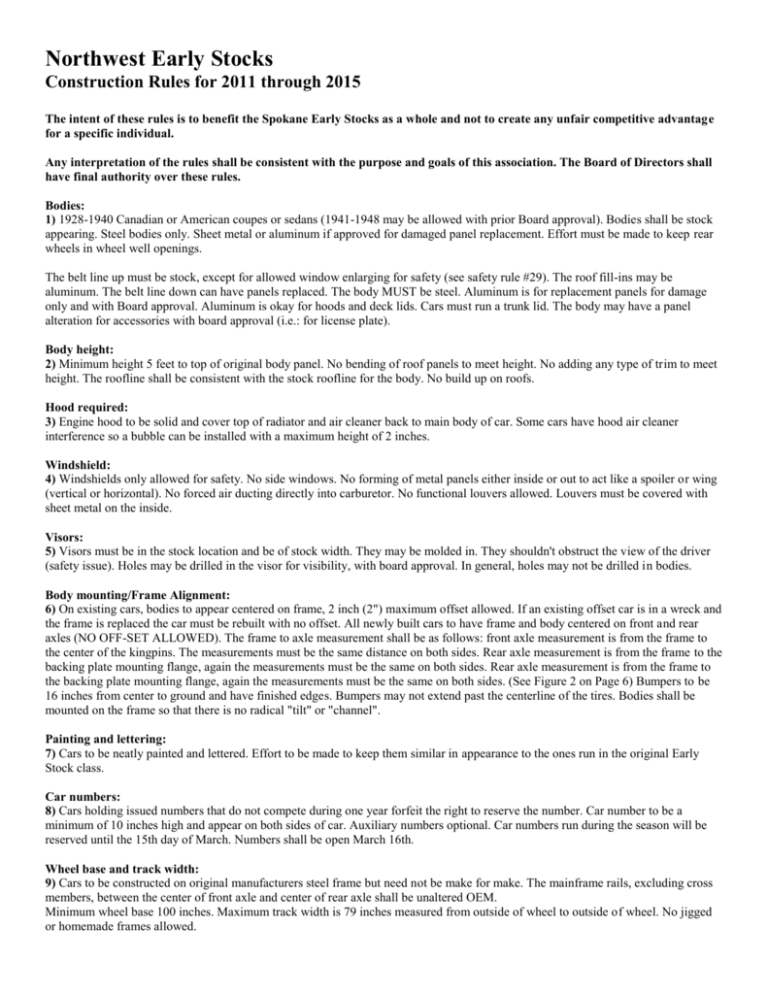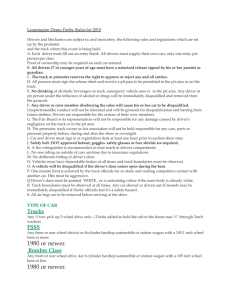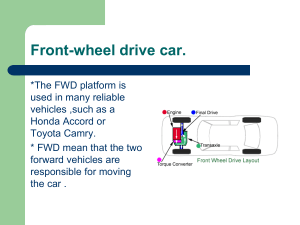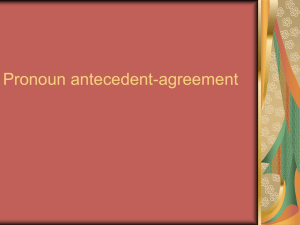Northwest Early Stocks Construction Rules for 2011 through 2015
advertisement

Northwest Early Stocks Construction Rules for 2011 through 2015 The intent of these rules is to benefit the Spokane Early Stocks as a whole and not to create any unfair competitive advantage for a specific individual. Any interpretation of the rules shall be consistent with the purpose and goals of this association. The Board of Directors shall have final authority over these rules. Bodies: 1) 1928-1940 Canadian or American coupes or sedans (1941-1948 may be allowed with prior Board approval). Bodies shall be stock appearing. Steel bodies only. Sheet metal or aluminum if approved for damaged panel replacement. Effort must be made to keep rear wheels in wheel well openings. The belt line up must be stock, except for allowed window enlarging for safety (see safety rule #29). The roof fill-ins may be aluminum. The belt line down can have panels replaced. The body MUST be steel. Aluminum is for replacement panels for damage only and with Board approval. Aluminum is okay for hoods and deck lids. Cars must run a trunk lid. The body may have a panel alteration for accessories with board approval (i.e.: for license plate). Body height: 2) Minimum height 5 feet to top of original body panel. No bending of roof panels to meet height. No adding any type of trim to meet height. The roofline shall be consistent with the stock roofline for the body. No build up on roofs. Hood required: 3) Engine hood to be solid and cover top of radiator and air cleaner back to main body of car. Some cars have hood air cleaner interference so a bubble can be installed with a maximum height of 2 inches. Windshield: 4) Windshields only allowed for safety. No side windows. No forming of metal panels either inside or out to act like a spoiler or wing (vertical or horizontal). No forced air ducting directly into carburetor. No functional louvers allowed. Louvers must be covered with sheet metal on the inside. Visors: 5) Visors must be in the stock location and be of stock width. They may be molded in. They shouldn't obstruct the view of the driver (safety issue). Holes may be drilled in the visor for visibility, with board approval. In general, holes may not be drilled in bodies. Body mounting/Frame Alignment: 6) On existing cars, bodies to appear centered on frame, 2 inch (2") maximum offset allowed. If an existing offset car is in a wreck and the frame is replaced the car must be rebuilt with no offset. All newly built cars to have frame and body centered on front and rear axles (NO OFF-SET ALLOWED). The frame to axle measurement shall be as follows: front axle measurement is from the frame to the center of the kingpins. The measurements must be the same distance on both sides. Rear axle measurement is from the frame to the backing plate mounting flange, again the measurements must be the same on both sides. Rear axle measurement is from the frame to the backing plate mounting flange, again the measurements must be the same on both sides. (See Figure 2 on Page 6) Bumpers to be 16 inches from center to ground and have finished edges. Bumpers may not extend past the centerline of the tires. Bodies shall be mounted on the frame so that there is no radical "tilt" or "channel". Painting and lettering: 7) Cars to be neatly painted and lettered. Effort to be made to keep them similar in appearance to the ones run in the original Early Stock class. Car numbers: 8) Cars holding issued numbers that do not compete during one year forfeit the right to reserve the number. Car number to be a minimum of 10 inches high and appear on both sides of car. Auxiliary numbers optional. Car numbers run during the season will be reserved until the 15th day of March. Numbers shall be open March 16th. Wheel base and track width: 9) Cars to be constructed on original manufacturers steel frame but need not be make for make. The mainframe rails, excluding cross members, between the center of front axle and center of rear axle shall be unaltered OEM. Minimum wheel base 100 inches. Maximum track width is 79 inches measured from outside of wheel to outside of wheel. No jigged or homemade frames allowed. Weight: 10) Minimum weight 2100 lbs wet. (not including driver) Suspension: 11) Car to have steel leaf spring suspension front and rear. No mono-leaf suspension. No independent suspension. Solid front axles only, or after market stock-appearing axles (with tech approval). No suicide or racing front ends. Front ends to be mounted in stocktype cross-member. No coil-over shocks. Front axles can have center section repaired with square tubing. To go from drop section of axle to drop section original width and drop to be retained. Maximum length of tubing 42 inches. Shocks will be limited to a welded steel body shock, one per wheel, no coil over and no adjustable shocks allowed. Steering: 12) No rack and pinion steering. Power steering allowed. Transmissions and clutches: 13) Any stock North American OEM production manual 3 or 4 speed or automatic transmission with functional torque converter. a) Automatic transmission cooler lines to be steel double flared. A maximum of 4 inches of hi-pressure hose double clamped. b) All vent lines to be sealed and plumbed to a minimum one-gallon catch can. All Automatic Transmission installations MUST pass Tech Inspection before the car runs. Clutch: 14) Stock type single disc clutches only, minimum of 10" diameter. No aluminum clutches. Stock weight, steel flywheels only. Tech must be able to inspect. Scatter Shield: 15) Cars to be equipped with scatter shields or suitable belting to cover bell housing. Engines: 16) Only Canadian or American in-line 6 cylinder or Flathead V-8s allowed. 310 cu. in. maximum. Heads: 17) Stock heads only, with stock valve size, make for make. No porting, polishing or any other method of enlarging or cleaning intake ports, exhaust ports, or combustion chambers allowed. Gaskets can be cut to match head or intake manifold. Surface grinding and replacement of stock valves with high performance is allowed, as long as stock valve size is retained. Machining of heads for HP valve springs allowed. Screw-in studs and roller rockers allowed. Flat tappet camshafts only. No mushroom lifters. a) Aluminum after market heads allowed on flatheads only, for cooling purposes. Valve Specifications: Rule #17 states that engines will have stock heads only, with stock valve sizes. Manufacturer's specifications define stock valve sizes as follow: Intake Exhaust Ford - 170, 200, 250 1.750 1.390 Ford - 223, 262 1.780 1.510 Ford - 240, 300 1.781 1.560 GM - 194, 230, 250, 292 1.720 1.500 GM - 235 1.937 1.500 GM - 261 (Pontiac) 1.875 1.500 Chrysler - 170, 198, 225 1.620 1.360 AMC - 223, 258 1.787 1.406 The valve measurements listed are the only measurements acceptable to the Tech committee for the stated engines. If your engine is not listed, or if you have questions, please contact a member of the Tech committee. NOTE: Engine may be torn down. If illegal, car will not be allowed to compete until legal. See protest rules. Carburetor: 18) One stock production Canadian or American downdraft single-barrel carburetor and manifold on OHV six cylinders. Flatheads will be allowed two 2-barrel carburetors, with restrictor plate <1" if needed to maintain the stock intake manifold size. The restrictor plate must be directly below the carburetor base. Slant 6 Chryslers may run (1) two-barrel carburetor with a stock two-barrel intake manifold. If using an adapter and/or spacer, the total thickness must not exceed 1". NO polishing or boring. Double return spring must be used. Engine Mounting: 19) No engine offsets permitted. Engine to be centered between frame rails and mounted perpendicular. (Slant six Dodge allowed) 5inch minimum clearance between oil pan and track surface. Engine Setback: 20) No radical engine setbacks. Minimum distance of 62 inches from center of rear axle to rear of engine casting (bell housing surface). Maximum of 8 inches from center of front axle to front of vibration dampener. Exhaust System: 21) Exhaust system optional but must be muffled to meet dB requirements at tracks. Must exit behind driver. Will be enforced. Maximum 90 decibels at 100 feet. Starters: 22) All cars must be self-starting. Fuel Pumps and Fuel: 23) No electric fuel pumps. No alcohol or methanol or exotic fuels. Tires: 24) Four required. Cars can run any combination of American Racer or Goodyear 225, 235, 245 or 265. Must be grooved and DOT approved with an 8" maximum tread width. No recaps. No dirt tires with DOT stencil. Use of chemical tire treatment is discouraged. Wheels: 25) Wheels are to be 8-inch maximum width of steel construction. RF hub to be machined for drum brake cars. 26) No racing radios are allowed in cars at anytime during competition. Roll Cage Padding: 27) Roll bars in close proximity of driver to be padded with no-melt/nomex-type roll bar padding. Top brace to be welded so that wheel or bumper cannot go through roof onto driver. Doors: 28) All doors to be securely fastened to body. Window openings: 29) The enlarging of both the passenger and driver windows is allowed for ingress and egress. Rear windows may be enlarged as a sight safety issue. NO reducing of window size. NO chopping. The top cage bar on the passenger and driver sides must come to the bottom of the window opening. The purpose of the bar height is to maintain the safety of the driver. If the bar is placed so low as to make it unsafe for the driver, it will not be approved. When opening up window openings for ingress and egress, open up as little as possible, for safety. The same applies to the rear window opening. At the same time, keep a stock-appearing body. This is NOT a modified class. Driver compartment: 30) Cars to have full floorboards to meet body panels on both sides. Full firewalls front and rear are required. Race Seats: 31) Seat to be securely bolted to roll cage or frame, NOT to floorboards. Seat to be an approved high back racing seat. Steering wheel: 32) Steering wheel centers to be padded. Seat belts/Shoulder harness: 33) Main seat belt and racing harness to be approved racing type and will not have a production date older than five (5) years old and will need to be approved by tech person. Batteries: 34) Batteries to be well secured out of driver's compartment. Battery disconnect mandatory in easy reach to outside of cars. All batteries must have a protective cover around it. Fire Extinguishers and Onboard Fire Systems: 35) A 2 1/2 lb. dry chemical fire extinguisher for each car shall be at its pit, in clear sight and easily accessible. ONLY Onboard systems allowed in car, but bottle must be mounted in a separate compartment from the driver. Having an onboard system does not take the place of the requirement to have an extinguisher in the pit. Fuel Cells: 36) Fuel cells mandatory. Fuel cells to be securely mounted behind rear-end housing and have a good firewall behind the driver. Fuel cell must be enclosed in metal can and have racing approved caps and proper ventilation. Radiator Catch Cans: 37) Radiator catch cans to be securely mounted, outside driver's compartment. Brakes: 38) Four wheel hydraulic brakes in working order. Disc allowed on front and rear. Vented OEM rear and OEM caliper (cast) single piston. Dual master cylinder required. The duel master cylinder requirement means either a single unit with two (2) pistons, or two single piston units. Drive Shafts: 39) All drive shafts must have 360-degree metal hoop securely fastened just behind the front universal joint, 1/4 x 1-inch steel. Drive shaft to be painted white. Driver Safety Equipment: 40) Drivers must have an SA type 2000 or newer, or Snell "M"-rated helmet with a fireproof sock to be approved for competition. If necessary, the age may be determined by the receipt for purchase. A helmet with apparent damage must be replaced. Drivers must wear nomex-type driving suits and gloves. 41) Driver must use arm restraints with open roof, or window net with closed roof. Window net not required if driver uses arm restraints. Drivers License: 42) Drivers to have valid driver's license and/or approved by Northwest Early Stocks Board. Ignition Cut-Off Switch: 43) The ignition switch shall be toggle type - NO rocker switches allowed - and shall be located within easy reach of the driver while buckled in. The switch shall be accessible from the outside of the car. Up is On and Down is Off. Switch is also to be labeled ON and OFF. Inspection by Technical/Safety Committee: Minimum of 2 people on the Tech/Safety Committee to inspect all cars. Tech officials may ask for the assistance of other members to complete a tech inspection, or any part thereof. All cars must pass inspection before permitted to run with Northwest Early Stocks. Cars currently approved to run with a "related" organization may be exempt from inspection unless there is an obvious safety concern. NO TOLERANCE. If a car is obviously not ready (eg. too low, too light, too noisy, etc.) or doesn't meet minimum safety requirements, then it doesn't race. NO funds will be received for any car that does not compete (promoter option). When the tech committee questions a car's rule application, it is brought to the Board and the car owner is invited to the meeting to discuss the rule in question. The car owner has the right to defend their rule application to the Board before a decision by the Board is made. Safety It is HIGHLY recommended that tech approval be received prior to final construction of new cages. Cages not in compliance with the rules will not be allowed. Cages must be made compliant before the car is allowed to compete. Measurement A: Rule 20 Maximum 8" from center of front axle to front of vibration damper. Measurement B: Rule 6 Frame and body to be centered on front and rear axles. Measurement for B must be the same distance from the kingpins to the frame on both sides. Measurement C: Rule 6 Frame and body to be centered on front and rear axles. Measurement for C must be the same distance from the axle flange to the frame on both sides. Measurement D: Rule 26 side Rub Rails (Nerf Bars) shall extend to at least the center of the tires and shall not extend beyond the tires. Rule 9: Minimum Wheelbase 100". Measured center of wheel to center of wheel. Maximum Track Width is 79 inches. Track width is measured from outside to outside edge of one wheel to the outside edge of the other wheel. Rule 6: Front and rear bumpers to be 16" from center to ground and have finished edges. Bumpers may not extend past the centerline of the tires. Roll Cage Diagram Figure 1 Chassis Dimensions Figure 2

![Limited_Late_Models_10_Rules[1]](http://s3.studylib.net/store/data/006839174_1-67335e3e45f29903f0bde89e699760b3-300x300.png)


